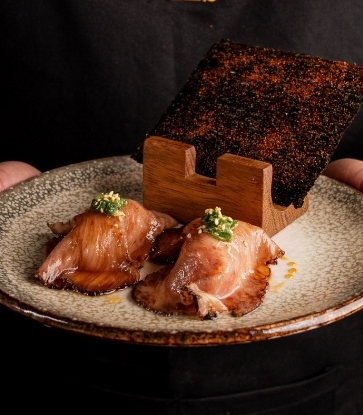Arabic bread, or pita bread, as it is more popularly known around the world, is a family of yeast-leavened round flatbreads baked from wheat flour.
There are several different types of pita bread, each with its unique characteristics. In this article, we look at some of the varieties of pita bread that exist across the Middle East, and how the restaurants in Dubai — a city known for its modernity and innovation in the F&B world — have introduced new twists to the age-old staple — creating magic with this simple concoction of flour, water, yeast and salt.
Khubz khameer
One of the most beloved and traditional breads in Emirati cuisine, khubz khameer is soft and slightly sweet and found in most local dining tables.Khameer means yeast in Arabic, so this confection naturally features yeast, along with flour and milk as a base, and sweetened with dates instead of sugar. A variety of spices can be added to flavour the bread, which is then garnished with a sprinkle of sesame seeds. Emiratis of yore would traditionally bake khubz khameer in a coal oven, but today, it is often cooked in a special oven-like metal pan that helps the bread puff up into two layers that separate easily. The result is a light, fluffy bread that makes the perfect accompaniment to a variety of Emirati dishes.
Where to try it: The khubz khameer can be found in restaurants across Dubai. For a unique take, head to moonrise, where their signature house khubz is made using a blend of locally milled flours, to underscore its young executive chef and co-owner Soleman Haddad’s mission to highlight local produce and producers. Instead of commercial yeast, moonrise’s khubz khameer and other breads feature their 530 day-fermented mother dough to add complexity and depth of flavour. The bread is made according to a technique that blends the essence of khubz, naan, and neapolitan pizza dough — as a nod to the diverse food cultures in Dubai, according to the Dubai-born Haddad.

Khubiz reqaq / reqaq
Drawing from the Arabic word Reqa, meaning thin, khubiz reqaq is a thin and crispy bread made with wholewheat flour. The bread dough is first flattened before being cooked on a griddle or hotplate, which gives the bread a crunchy texture for those who prefer some bite. Another mainstay in Emirati homes, especially for dinner during Ramadan, khubiz reqaq can be paired with meat dishes such as thereed, a popular Iftar dish enjoyed around the Ramadan season, or savoured rolled up with honey or cheese and sugar.Where to try it: Bib Gourmand-distinguished venue Al-Fanar Restaurant & Café takes great pride in preserving the traditional recipes and techniques of iconic Arabic flatbreads while also adapting them to contemporary tastes. The restaurant makes their khubiz reqaq fresh daily, which can be enjoyed for breakfast with eggs, cheese or honey, or as a side to accompany heartier meat dishes. Presentation styles also vary to make the bread more appealing to the modern palate.

Chebab
Closer in appearance to a pancake, this thin, crisp, and sweet bread is made using the same ingredients, with the addition of yeast, cardamom, and turmeric. Derived from the word cheb, which means flipping over in Arabic, chebab is made by cooking bread in an Arabic bread oven until it has turned golden on both sides. This bread is traditionally enjoyed for breakfast with a dollop of cheese or a drizzle of date syrup and a sprinkle of sesame seeds, or at Suhoor, the meal before dawn during Ramadan.Where to try it: Bib Gourmand-recognised Al Khayma Heritage Restaurant offers chebab as part of their all-day breakfast menu. Their saffron and cardamom-infused version is made fresh daily in the courtyard of a restored traditional Emirati house, and served with butter, honey, date syrup and jam. Want to learn to make it yourself? The restaurant also regularly conducts three-course cooking classes onsite. Or, give it a try at home with this recipe from Al-Fanar.

Taftoon
A staple bread in Persian cuisine, taftoon (sometimes called nan-e-taftoon in Iran) is a fluffy flatbread that is devoured as a side with delicious curries, stews, and soups. It is traditionally prepared with wheat flour, salt, sugar, yeast and saffron, though modern recipes may incorporate eggs, butter, milk and yoghurt. The addition of saffron gives the thin, oval-shaped bread its attractive golden hue and delicious fragrance after being baked in an oven, while poppy or nigella seeds are often sprinkled atop for extra texture and more intense aromaWhere to try it: At Bib Gourmand-rated Persian restaurant, Shabestan, you will be greeted upon arrival with a piping hot taftoon straight out of the oven. It is best enjoyed with a mast o kheir (yoghurt) and feta cheese salad for a tantalising start to the dining experience. Shabestan's taftoon flatbreads are baked in a traditional clay oven and, like much of the heritage Persian recipes on the restaurant’s menu, they owe their deliciousness to a highly guarded recipe passed down from father, Chef Shirazi, to son, Chef Abol Fazl.

Manakeesh
Popular throughout the Middle East, manakeesh is a round, pizza-like Lebanese flatbread made with a simple dough and topped with olive oil and various toppings, typically za'atar — a blend of wild oregano, toasted sesame seeds and sumac — and a brined cheese known as Akkawi. It is usually enjoyed at breakfast or lunch with fresh vegetables and tea.Where to try it: The manakeesh is a hot favourite at MICHELIN-recommended Lebanese restaurant, Al Mandaloun, so much so that there’s an entire section of the menu dedicated to it. You can opt to have yours with 14 different combinations of toppings, from traditional shredded cheese to minced lamb or labneh, a tangy Lebanese take on cream cheese.


















